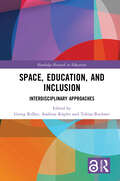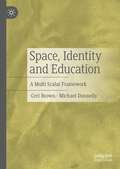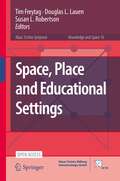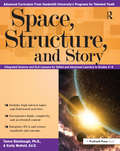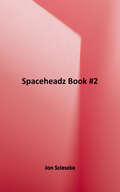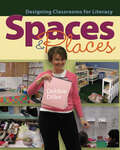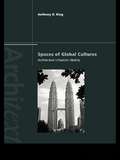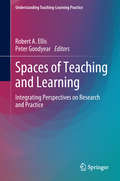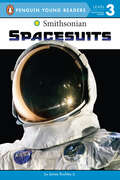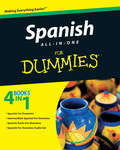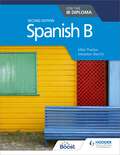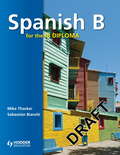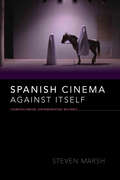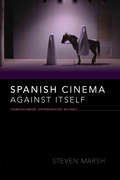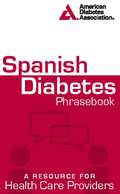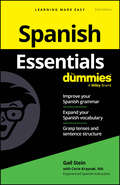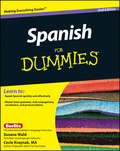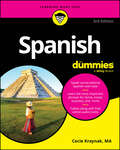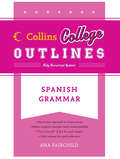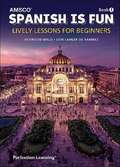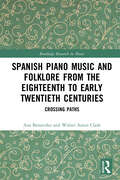- Table View
- List View
Space, Education, and Inclusion: Interdisciplinary Approaches (Routledge Research in Education)
by Tobias Buchner Georg Rißler Andreas KöpferThis timely, edited volume brings together interdisciplinary perspectives on space and spatiality in inclusive education discourses. With research from an international range of scholars, the book explores the intersections, boundaries, and intermediary spaces of inclusion and exclusion within educational contexts. It advances thinking in inclusive education research and links discourses of the spatial turn in inclusive education with a call for thinking spatially. Instead of defining one spatial approach as the overarching framework for analysis, it considers the potential of combining spatial approaches from diverse disciplines, including social sciences, educational science, and geography. The book systematically identifies and links the relations between a diversity of spatial theoretical perspectives and phenomena of inclusion/exclusion. This volume provides invaluable, transdisciplinary readings and reflections on space and spatiality in inclusive education, and will be highly relevant for academics, researchers and postgraduate students in the fields of inclusive education, educational theory and the sociology of education.
Space, Education, and Inclusion: Interdisciplinary Approaches (Routledge Research in Education)
by Tobias Buchner Georg Rißler Andreas KöpferThis timely, edited volume brings together interdisciplinary perspectives on space and spatiality in inclusive education discourses.With research from an international range of scholars, the book explores the intersections, boundaries, and intermediary spaces of inclusion and exclusion within educational contexts. It advances thinking in inclusive education research and links discourses of the spatial turn in inclusive education with a call for thinking spatially. Instead of defining one spatial approach as the overarching framework for analysis, it considers the potential of combining spatial approaches from diverse disciplines, including social sciences, educational science, and geography. The book systematically identifies and links the relations between a diversity of spatial theoretical perspectives and phenomena of inclusion/exclusion.This volume provides invaluable, transdisciplinary readings and reflections on space and spatiality in inclusive education, and will be highly relevant for academics, researchers and postgraduate students in the fields of inclusive education, educational theory and the sociology of education.
Space, Identity and Education: A Multi Scalar Framework
by Michael Donnelly Ceri BrownThis book details an innovative multi-scalar framework to examine the intersection of spatial levels in shaping social justice issues in education. Including an examination of key dimensions such as geographic divisions (between and within countries), school design, online learning, home-schooling, and student mobility, the framework is applied to analyse the interrelation between space, identity, and education. The authors reveal how this novel integration of scales is essential for a more comprehensive and probing understanding of educational inequalities. As an example of theoretical interdisciplinarity mobilised to tackle the urgent issues of our time, the twin dimensions of space and identity, discussed at multi-scalar levels, provides an invaluable theoretical resource for scholars and students of education, sociology and geography.
Space, Place and Autonomy in Language Learning (Routledge Research in Language Education)
by Garold Murray Terry LambThis book explores theories of space and place in relation to autonomy in language learning. Encompassing a wide range of linguistically and culturally diverse learning contexts, this edited collection brings together research papers from academics working in fourteen countries. In their studies, these researchers examine physical, virtual and metaphorical learning spaces from a wide range of theoretical and interdisciplinary perspectives (semiotic, ecological, complexity, human geography, linguistic landscapes, mediated discourse analysis, sociocultural, constructivist and social constructivist) and methodological approaches. The book traces its origins to the first-ever symposium on space, place and autonomy, which was held at the International Association of Applied Linguistics (AILA) 2014 World Congress in Brisbane. The final chapter, which presents a thematic analysis of the papers in this volume, discusses the implications for theory development, further enquiry, and pedagogical practice.
Space, Place and Educational Settings (Knowledge and Space #16)
by Tim Freytag Douglas L. Lauen Susan L. RobertsonThis open access book explores the nexus between knowledge and space with a particular emphasis on the role of educational settings that are, both, shaping and being reshaped by socio-economic and political processes. It gives insight into the complex interplay of educational inequalities and practices of educational governance in the neighborhood and at larger geographical scales. The book adopts quantitative and qualitative methodologies and explores a wide range of theoretical perspectives by drawing upon empirical cases and examples from France, Germany, Italy, the UK and North America, and presents and reflects ongoing research of international scholars from various disciplinary backgrounds such as education, human geography, public policy, sociology, and urban and regional planning. As such, it provides an interesting read for scholars, students and professionals in the broader field of social, cultural and educational studies, as well as policy makers and practitioners in the fields of education, pedagogy, social work, and urban and regional planning.
Space, Structure, and Story: Integrated Science and ELA Lessons for Gifted and Advanced Learners in Grades 4-6
by Tamra Stambaugh Emily MofieldWinner of the 2017 NAGC Curriculum Studies Award Space, Structure, and Story integrates Earth and space science with science fiction and nonfiction texts, poetry, and art. This unit, developed by Vanderbilt University's Programs for Talented Youth, is aligned to the Common Core State Standards and Next Generation Science Standards. Students explore advanced science and ELA content through the lens of structure—its parts, purpose, and function. Mobius strips, the hero's journey, dystopian fiction, black holes, Einstein's relativity, stars, and moons are just a few of the captivating in-depth topics explored through accelerated content, engaging activities, and differentiated tasks. Ideal for gifted classrooms or gifted pull-out groups, the unit features poetry from Carl Sandburg, Henry Wadsworth Longfellow, and C. S. Lewis; art from M. C. Escher, Vincent Van Gogh, Claude Monet, and Salvador Dali; a novel study featuring A Wrinkle in Time by Madeleine L'Engle; short stories from Isaac Asimov and Ray Bradbury; speeches from President John F. Kennedy and President Barack Obama; and informational texts about gravity, orbits, and black holes. Grades 4-6
Spaceheadz Book #2! (Spaceheadz Ser. #2)
by Jon ScieszkaThe campaign to save the earth from being turned off is going well, but Michael K. must enlist fellow fifth-graders Venus and TJ to help hide the SPHDZ from Agent Umber, especially when they become involved in a school play.
Spaces & Places: Designing Classrooms for Literacy
by Debbie DillerFrom Debbie Diller, author of numerous best-selling books and videos on literacy work stations and small group reading instruction, comes another practical resource filled with ideas you can use immediately to better manage your classroom and support student learning and independence. In Spaces & Places: Designing Classrooms for Literacy' you' ll find a wealth of full-color photos from all sorts of classroom spaces in PreK-5th grade, including well-organized areas for whole group and small group reading instruction, classroom libraries, literacy work stations, teacher desks, and storage areas. You' ll love the before and after pictures and the step-by-step processes outlined for organizing your furniture and cabinets, setting up your room space by space, and using your walls thoughtfully. Diller' has even documented how to pack your room at the end of the year to save time next fall (so you can focus on thinking about instruction) and what to do if you must move all your belongings. Through pictures and text, this unique visual reference answers tough questions educators ask, such as: What do I really need in my room and what' s the best way to set it up? How does my physical classroom impact student learning? How can I find the space I need to teach more effectively? What can I get rid of and how? Where do I put all my stuff?Charts, reproducible forms, motivating quotes, a list of shopping sources, and reflection questions are included, along with a section outlining ten specific suggestions for on-going staff development. Whether or not you implement literacy work stations in your classroom, Spaces & Placesincludes everything you need to look deeply at classroom space and how it supports instruction.
Spaces of Global Cultures: Architecture, Urbanism, Identity (Architext)
by Anthony KingThis book brings together a series of new and historical case studies to show how different phases of globalization are transforming the built environment. Taking a broad interdisciplinary approach, the author draws on sociological, geographical, cultural and postcolonial studies to provide a critical account of the development of three key concepts: global culture, post colonialism, and modernity. Subsequent case studies examine how global economic, political and cultural forces shape the forms of architectural and urban modernity in globalized suburbs and spaces in major cities worldwide. The first book to combine global and postcolonial theoretical approaches to the built environment and to illustrate these with examples, Spaces of Global Cultures argues for a more historical and interdisciplinary understanding of globalization: one that places material space and the built environment at the centre and calls for new theories to address new conditions.
Spaces of Teaching and Learning
by Peter Goodyear Robert A. EllisThis integrated collection of perspectives on the spaces of teaching and learning uses ‘learning space’ to place educational practice in context. It considers the complex relationships involved in the design, management and use of contemporary learning spaces. It sheds light on some of the problems of connecting the characteristics of spaces to the practices and outcomes of teaching and learning. The contributions show how research into learning spaces can inform broader educational practices and how the practices of teaching, learning and design can inform research. The selection of chapters demonstrates the value of gathering together multiple sources of evidence, viewed through different epistemological lenses in order to push the field forward in a timely fashion. The book provides both a broad review of current practices as well as a deep-dive into particular educational and epistemological challenges that the various approaches adopted entail. Contrasts and commonalities between the different approaches emphasise the importance of developing a broad, robust evidence-base for practice in context. This is the inaugural book in the series Understanding Teaching-Learning Practice.
Spacesuits (Smithsonian)
by James BuckleyWhat does an astronaut wear to work? Find out in this space-age Penguin-Smithsonian reader!If you're going to orbit the Earth, moonwalk, or float in space, you need the right outfit. From helmet to space boots, every part of an astronaut's spacesuit is designed for survival. This reader, developed with Smithsonian's popular Air and Space Museum, provides a close look at the suits, boots, helmets, gloves, and other gear astronauts have worn into space, from the early days of space exploration to the present-day.
Spanish All-in-One For Dummies
by The Experts at For DummiesA value-packed guide to speaking, reading, and writing in Spanish Spanish All-in-One For Dummies is the first Dummies All-in-One title in the foreign language category–nearly 800 pages of expert instruction to help people master Spanish basics and beyond. This comprehensive volume features content from all For Dummies Spanish language instruction titles, including Spanish For Dummies, Intermediate Spanish For Dummies, Spanish Verbs For Dummies, and Spanish For Dummies Audio Set. The book's audio CD provides readers with an effective tool to help them start speaking Spanish from day one. Plus, the practical exercises give readers greater confidence in communicating in Spanish, whether traveling or in business.
Spanish B for the IB Diploma Second Edition
by Mike Thacker Sebastian BianchiExam board: International BaccalaureateLevel: IB DiplomaSubject: SpanishFirst teaching: September 2018First exams: Summer 2020Develop competent communicators who can demonstrate a sound conceptual understanding of the language with a flexible course that ensures thorough coverage of the updated Spanish B Guide and is designed to meet the needs of all IB students at Standard and Higher Level.- Empower students to communicate confidently by exploring the five prescribed themes through authentic texts and skills practice at the right level, delivered in clear learning pathways. - Ensure students are able to produce coherent written texts and deliver proficient presentations with grammar and vocabulary introduced in context and in relation to appropriate spoken and written registers. - Improve receptive skills with authentic written texts, audio recordings spoken at a natural pace, and carefully crafted reading and listening tasks.- Promote global citizenship, intercultural understanding and an appreciation of Hispanic cultures through a wide range of text types and cultural material from around the world. - Deliver effective practice with a range of structured tasks within each unit that build reading, listening, speaking and writing skills.- Establish meaningful links to TOK and CAS, and identify learner profile attributes in action.The audio for the Student Book is FREE to download from www.hoddereducation.com/ibextras
Spanish B for the IB Diploma Second Edition
by Mike Thacker Sebastian BianchiExam board: International BaccalaureateLevel: IB DiplomaSubject: SpanishFirst teaching: September 2018First exams: Summer 2020Develop competent communicators who can demonstrate a sound conceptual understanding of the language with a flexible course that ensures thorough coverage of the updated Spanish B Guide and is designed to meet the needs of all IB students at Standard and Higher Level.- Empower students to communicate confidently by exploring the five prescribed themes through authentic texts and skills practice at the right level, delivered in clear learning pathways. - Ensure students are able to produce coherent written texts and deliver proficient presentations with grammar and vocabulary introduced in context and in relation to appropriate spoken and written registers. - Improve receptive skills with authentic written texts, audio recordings spoken at a natural pace, and carefully crafted reading and listening tasks.- Promote global citizenship, intercultural understanding and an appreciation of Hispanic cultures through a wide range of text types and cultural material from around the world. - Deliver effective practice with a range of structured tasks within each unit that build reading, listening, speaking and writing skills.- Establish meaningful links to TOK and CAS, and identify learner profile attributes in action.The audio for the Student Book is FREE to download from www.hoddereducation.com/ibextras
Spanish B for the IB Diploma Second Edition
by Mike Thacker Sebastian BianchiExam board: International BaccalaureateLevel: IB DiplomaSubject: SpanishFirst teaching: September 2018First exams: Summer 2020Develop competent communicators who can demonstrate a sound conceptual understanding of the language with a flexible course that ensures thorough coverage of the updated Spanish B Guide and is designed to meet the needs of all IB students at Standard and Higher Level.- Empower students to communicate confidently by exploring the five prescribed themes through authentic texts and skills practice at the right level, delivered in clear learning pathways. - Ensure students are able to produce coherent written texts and deliver proficient presentations with grammar and vocabulary introduced in context and in relation to appropriate spoken and written registers. - Improve receptive skills with authentic written texts, audio recordings spoken at a natural pace, and carefully crafted reading and listening tasks.- Promote global citizenship, intercultural understanding and an appreciation of Hispanic cultures through a wide range of text types and cultural material from around the world. - Deliver effective practice with a range of structured tasks within each unit that build reading, listening, speaking and writing skills.- Establish meaningful links to TOK and CAS, and identify learner profile attributes in action.The audio for the Student Book is FREE to download from www.hoddereducation.com/ibextras
Spanish B for the IB Diploma Student's Book
by John Bates Mike Thacker Sebastian BianchiDevelop confident linguists, who appreciate other cultures with this course, based closely around the IB's desired learner profile.This text caters for Language B - students learning Spanish as a second language at Standard and Higher levels. It includes a starter unit to help bridge the gap from pre-16 exams into the distinctive requirements of the IB Diploma. - Builds language skills through carefully crafted tasks and grammar practice- Improves exam performance with activities for all aspects of IB Spanish assessment- Promotes global citizenship and an appreciation of Hispanic culture through stimulus material, including a particular emphasis on the Americas
Spanish Cinema Against Itself: Cosmopolitanism, Experimentation, Militancy (New Directions in National Cinemas)
by Steven Marsh“An extraordinary philosophical exploration of the political potential and continued political commitment of cinema today . . . An essential read.” —Patricia Keller, Associate Professor of Spanish and Comparative Literature, Cornell UniversitySpanish Cinema Against Itself maps the evolution of Spanish surrealist and politically committed cinematic traditions from their origins in the 1930s—with the work of Luis Buñuel and Salvador Dalí, experimentalist José Val de Omar, and militant documentary filmmaker Carlos Velo—through to the contemporary period. Framed by film theory this book traces the works of understudied and non-canonical Spanish filmmakers, producers, and film collectives to open up alternate, more cosmopolitan and philosophical spaces for film discussion. In an age of the post-national and the postcinematic, Steven Marsh’s work challenges conventional historiographical discourse, the concept of “national cinema,” and questions of form in cinematic practice.“In this exhilarating counter-history of experimental filmmaking in Spain, Steven Marsh takes up the politics of form, the trouble with film history, and the theoretical potential of haunting, discontinuity, and absence . . . Spanish Cinema Against Itself is an important intervention in Spanish film studies and, indeed, in the scholarship on world cinema.” —Rosalind Galt, Professor of Film Studies, King’s College London
Spanish Cinema against Itself: Cosmopolitanism, Experimentation, Militancy (New Directions in National Cinemas)
by Steven MarshSpanish Cinema against Itself maps the evolution of Spanish surrealist and politically committed cinematic traditions from their origins in the 1930s—with the work of Luis Buñuel and Salvador Dalí, experimentalist José Val de Omar, and militant documentary filmmaker Carlos Velo—through to the contemporary period. Framed by film theory this book traces the works of understudied and non-canonical Spanish filmmakers, producers, and film collectives to open up alternate, more cosmopolitan and philosophical spaces for film discussion. In an age of the post-national and the postcinematic, Steven Marsh's work challenges conventional historiographical discourse, the concept of "national cinema," and questions of form in cinematic practice.
Spanish Diabetes Phrasebook
by American Diabetes AssociationThe only Spanish-English resource to help you communicate with your patients with diabetesWith more and more physicians, clinicians, educators, and administrators working with Latino and Hispanic patients, ensuring accurate communication is more important than ever. This handy pocket reference offers the Spanish equivalents to common phrases you use every day. From patient introductions to medical histories, examinations, and follow-up, you can provide a more trusting environment and quality care by engaging patients directly.Phrases are divided into nine, natural groups for ease of use. A glossary of related terms is included, Diabetes Spanish Phrasebook provides accurate communication, critical in all aspects of medical diagnosis, education, and general diabetes care to help you communicate more effectively with your Spanish-speaking patients.Written by the experts at the American Diabetes Association, the nation's leading voluntary health organization supporting diabetes research, information, and advocacy and the leading publisher of comprehensive diabetes information.Topics include:Greeting and IntroductionIdentifying the PatientMedications and AllergiesChief Complaint (CC)History of Present IllnessPast Medical HistoryReview of SystemsExaminationFollow-Up and PlanList of Relevant Terms
Spanish Essentials For Dummies
by Gail SteinThe perfect guide for new Spanish learners and anyone looking for an expert refresher Interested in a fast and effective guide to learning Spanish that avoids fluff and focuses on key concepts that you need to know to improve your ability to speak, write, and understand the language? Spanish Essentials For Dummies, 2nd Edition walks you through Spanish fundamentals you can use for at-home, solo learning, to supplement your progress in a Spanish class, or as a companion to language instruction. Inside: Get practical tips on Spanish grammar, pronunciation, and sentence structure See conversational Spanish examples to amplify your learning Understand all the core concepts taught and tested in a typical introductory Spanish course Perfect for Spanish students looking for a quick reference to supplement classroom or app-assisted Spanish learning, Spanish Essentials For Dummies, 2nd Edition is a great resource for everyone looking to brush up on their conversational Spanish.
Spanish For Dummies
by Susana Wald Cecie KraynakLearn Latin American Spanish quickly and painlessly The job market for those who are bilingual is expanding rapidly. Businesses and government agencies are hiring translators; retailers and advertisers are concentrating more energy in targeting the Spanish-speaking ; and hospitals and agencies are seeking to overcome language barriers. Whether you’re a student studying Spanish, a traveler gearing up for a trip to a Spanish-speaking country and need to learn the basics, or a upwardly mobile looking to get ahead of the pack in your career by learning a second language, Spanish For Dummies, 2nd edition is your hands-on guide to quickly and painlessly learn Latin American Spanish that includes: Expanded coverage of grammar, verb conjugations, and pronunciations A refreshed and expanded mini-dictionary complete with even more essential vocabulary, exercises, and more A revamped and expanded bonus CD-ROM that includes real-life dialogue to aid in your learning Whether you’re looking to learn Spanish for use in the home, class, at the office, or on the go, Spanish For Dummies, 2nd edition has you covered!
Spanish For Dummies
by Cecie KraynakLearn to speak Latin American Spanish with confidence—the easy way Spanish For Dummies gets you started with the Spanish language, even if you've never learned a language before. The trusted Dummies language learning method is quick and practical, so you'll know what to say and do when traveling to a Spanish-speaking country or interacting with Spanish speakers in your community. You'll learn the basics of Spanish grammar and pronunciation, and then you'll explore common phrases you'll need in everyday situations. Get ready to study, work, or travel abroad—or integrate Spanish into your everyday life. This essential resource helps you make small talk, understand common expressions, navigate business settings, ask for directions, go to the doctor, and beyond. Learn how Latin American Spanish works—grammar, pronunciation, and important constructions Build your vocabulary and learn common expressions you'll hear while abroad Brush up your conversation skills with authentic dialogues, plus follow along with online audio Get practice reading, writing, and speaking Spanish, so you're ready to communicate effectively With Spanish For Dummies, students, travelers, and business professionals can gain the confidence to converse in Spanish.
Spanish Grammar
by Ana Laura Tello Fairchild Juan MendezUnlike traditional textbooks, which leave students without a clear understanding of the different tenses and moods, the Collins College Outline for Spanish Grammar is organized conceptually, explaining in detail subjunctive and imperative moods, passive voice, negatives, idioms, and the rules of accentuation. With sections on articles, adjectives, nouns, and verbs, along with a comprehensive vocabulary appendix for quick and easy reference, this is the essential guide to understanding Spanish. Completely revised and updated by Professor Ana Fairchild, this book includes a test yourself section with answers and complete explanations at the end of each chapter. Also included are bibliographies for further reading, as well as numerous vocabulary lists, exercises, and examples. The Collins College Outlines are a completely revised, in-depth series of study guides for all areas of study, including the Humanities, Social Sciences, Mathematics, Science, Language, History, and Business. Featuring the most up-to-date information, each book is written by a seasoned professor in the field and focuses on a simplified and general overview of the subject for college students and, where appropriate, Advanced Placement students. Each Collins College Outline is fully integrated with the major curriculum for its subject and is a perfect supplement for any standard textbook.
Spanish Is Fun: Lively Lessons for Beginners, Book 1
by Heywood Wald Lori Langer de RamirezThis introductory program is designed to help students attain a desired first-year level of proficiency in four basic skills--speaking, listening, reading, and writing.
Spanish Piano Music and Folklore from the Eighteenth to Early Twentieth Centuries: Crossing Paths (Routledge Research in Music)
by Ana BenavidesThis is a pioneering work on the study of popular music—songs and dances—from the eighteenth to early twentieth centuries. The piano was the dominant solo instrument in European art music of this period, including Spanish, and Ana Benavides uses this as a vehicle for examining a wide variety of vernacular songs and dances, offering a wealth of musical, historical, and ethnographic insight. First published in Spanish in 2019, this translation by Walter Aaron Clark shows how one of the most frequent and established practices in the history of Western art music has been the borrowing and reinterpretation of traditional and popular musics, which reflect the lives and spirit of those outside the upper social strata. This volume provides an exploration of specific folk-inspired works with an inquiry into the historical cross-pollination between popular and classical musical idioms. It will prove invaluable not only to pianists but also to scholars, performers, and students in general.
